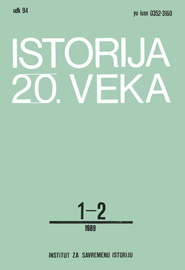HLADNI RAT (1947 - 1950) PREMA AMERIČKIM ISTORIJSKIM IZVORIMA
COLD WAR (1947 - 1950) IN AMERICAN HISTORICAL SOURCES
Author(s): Radoje NenadovićSubject(s): Diplomatic history, Military history, Political history, Recent History (1900 till today), WW II and following years (1940 - 1949), Post-War period (1950 - 1989), History of Communism
Published by: Institut za savremenu istoriju, Beograd
Keywords: American historical sources; cold war; 1947-1950; US foreign policy; Soviet Union; Truman doctrine; Korean war; fear of communism; Marshall plan;
Summary/Abstract: The subject of this work are the events which took place during the Cold War from 1947. to 1950. It also considered the United States foreign policy, particularly towards the Soviet Union in a period marked by two extremely important historical events - the declaration of the Truman Doctrine arid the outburst of the Korean War. The Truman Doctrine was a milestone in American history for many reasons. Among others it marked the point at which Truman used the fear of communism, both at home and abroad, to convince the Americans that they must em bark upon a Cold War foreign policy. On the other hand, Truman used the Doctrine to justify a gigantic aid program to prevent a collapse of the European and American economies. The president's program evolved naturally into the Marshall Plan. The Secretary of State George Marshall urged Europeans to create a long-term program that would help rebuilding Europe. The State Department agreed that the restoration of Europe involved the restoration of Germany; without a revival of German production there could be no revival of Europe's economy. The Marshall Plan served as an all purpose weapon for Truman’s foreign policy. It also marked the last phase in the Administrations use of economic tactics as the primary means of tying together the Western world. How such programs could easily be transform ed into military commitments was explained by the chief of the Policy Planning Staff, George Kennan. He emphasized that the Soviet aggression could be contained by application of counter force at a series of constantly shifting geographic a land political points. The military and personal costs of the Truman Doctrine - „Mr. X" policy became apparent as Truman and Edgar Hoover carried out the Presidents Security Loyalty Program which clearly shows how the ground was carefully plowed around Truman for the weeds of McCarthysm. At the end of part one, this paper analyses the establishing of the Com inform and the fall of Czechoslovakia. The second part of this work encircles the time from the beginning of the Berlin Crisis, to the time when the war in Korea was about to begin. The United States-view of European Future is compared with the Soviet angle: America stressed that the prosperity of Western Europe depended on German industrial recovery. The Soviets, however, predicted their European policy on weakened non-western Central Europe. Further on it is described what were the major points of president Truman’s foreign policy (support of the UN, encouragement of European recovery, etc.). Thoroughly considered in this papers were the Senate hearings on the Nato pact and the dilemma of the State Department - Does China deserve more attention in the United States foreign policy than Europe. The Sino-Soviet pact, the explosion of the Russian bomb and the divisive arguments over Nato added up to an unpleasant period for the Truman Administration. The answer was found in early 1950. when the National Security Council began work on a highly secret document known as NSC-68. Its purpose was to be the American blueprint for waging the Cold War during the next twenty years, and was ready for implementation when Korea burst into war.
Journal: Istorija 20. veka
- Issue Year: 1989
- Issue No: 1+2
- Page Range: 141-168
- Page Count: 28
- Language: Serbian

